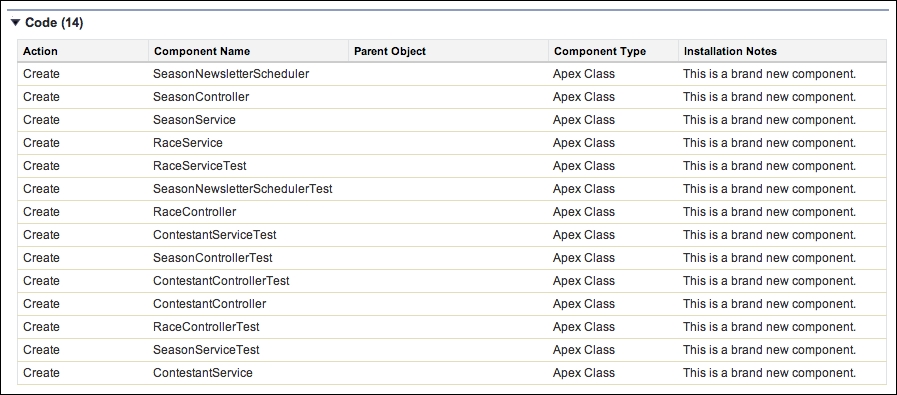- Force.com Enterprise Architecture - Second Edition
- Table of Contents
- Force.com Enterprise Architecture - Second Edition
- Credits
- Foreword
- About the Author
- Acknowledgements
- About the Reviewers
- www.PacktPub.com
- Customer Feedback
- Preface
- 1. Building, Publishing, and Supporting Your Application
- Required organizations
- Introducing the book's sample application
- Package types and benefits
- Creating your first managed package
- Package dependencies and uploading
- Becoming a Salesforce partner and benefits
- Introduction to AppExchange and listings
- Installing and testing your package
- Licensing
- Providing support
- Customer metrics
- Trialforce and Test Drive
- Summary
- 2. Leveraging Platform Features
- Packaging and upgradable components
- Understanding the custom field features
- Understanding the available security features
- Platform APIs
- Localization and translation
- Building customizable user interfaces
- E-mail customization with e-mail templates
- Process Builder, Workflow and Flow
- Social features and mobile
- Summary
- 3. Application Storage
- Mapping out end user storage requirements
- Understanding the different storage types
- Reusing the existing Standard Objects
- Importing and exporting data
- Options for replicating and archiving data
- External data sources
- Summary
- 4. Apex Execution and Separation of Concerns
- 5. Application Service Layer
- 6. Application Domain Layer
- Introducing the Domain layer pattern
- Implementation design guidelines
- Domain class template
- Implementing Domain Trigger logic
- Implementing custom Domain logic
- Object-oriented programming
- Creating a compliance application framework
- An Apex interface example
- Testing the Domain layer
- Calling the Domain layer
- Updating the FormulaForce package
- Summary
- 7. Application Selector Layer
- 8. User Interface
- Which devices should you target?
- Introducing Salesforce Standard UIs and Lightning
- Leveraging the Salesforce standard UIs
- Generating downloadable content
- Generating printable content
- Client server communication
- Managing limits
- Object and field-level security
- Managing performance and response times
- Using the Service layer and database access
- Considerations for using JavaScript libraries
- Custom Publisher Actions
- Creating websites and communities
- Mobile application strategy
- Custom reporting and the Analytics API
- Updating the FormulaForce package
- Summary
- 9. Lightning
- Building a basic Lightning user interface
- Lightning architecture
- FormulaForce Lightning Components
- Making components customizable
- Integrating with Lightning Experience
- Lightning Out and Visualforce
- Integrating with communities
- Testing
- Updating the FormulaForce package
- Summary
- 10. Providing Integration and Extensibility
- Reviewing your integration and extensibility needs
- Force.com platform APIs for integration
- Application integration APIs
- Exposing Lightning Components
- Extending Process Builder and Visualflow
- Alignment with Force.com extensibility features
- Extending the application logic with Apex interfaces
- Summary
- 11. Asynchronous Processing and Big Data Volumes
- 12. Unit Testing
- 13. Source Control and Continuous Integration
- Development workflow and infrastructure
- Developing with Source Control
- Hooking up Continuous Integration
- Releasing from Source Control
- Automated regression testing
- Summary
- Index
The source code provided with this chapter contains skeleton Apex classes shown in the UML diagrams used earlier in this chapter. In the upcoming chapters, we will flesh out the methods and logic within them. For now, deploy them into your packaging org and add them into your package. Note that once you add Apex classes, any Apex classes they subsequently go on to reference will be automatically pulled into the package. The following is a list of the Apex classes added in this chapter and the application architecture layer they apply to:
|
Apex class |
Layer |
|---|---|
|
|
Visualforce Controller |
|
|
Apex test |
|
|
Visualforce Controller |
|
|
Apex test |
|
|
Visualforce Controller |
|
|
Apex test |
|
|
Apex Scheduler |
|
|
Apex test |
|
|
Race Service |
|
|
Apex test |
|
|
Season Service |
|
|
Apex test |
|
|
Contestant Service |
|
|
Apex test |
Note
Note that there is one class, SeasonNewsLetterSchedule, that requires the use of the global access modifier. This ensures that this class cannot be deleted or renamed in future releases. This might feel restrictive, but is the key to supporting the Apex Scheduler feature in this case. As it is important when users upgrade to new versions of your package, the schedules they have defined continue to reference the code in your package.
Upload a new version of the package and install it into your test org. You should see a confirmation install summary page that looks something like the following:

-
No Comment
